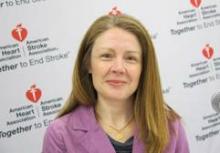SAN DIEGO – Eleven of every 100,000 patients younger than 50 years who were seen for traumatic injury developed an ischemic stroke within 4 weeks, a study of data on 1.3 million people found.
Patients with head or neck trauma were three times more likely overall to have a stroke than were those who had other forms of trauma, although the risk varied by age, Dr. Heather Fullerton said in a press briefing at the International Stroke Conference, sponsored by the American Heart Association. Among those with head or neck trauma, ischemic strokes occurred in 0.01% of the children and in 0.05% of the adults within a month of being seen.
Rates in both those age groups were significantly higher than rates reported in the literature for similar ages in the general population, she added.
"Strokes are something that affect young people, not just older people, particularly after a traumatic event," the findings showed, so people should apply the FAST criteria for recognizing the warning signs of stroke to potential stroke victims of any age, Dr. Fullerton said. The FAST acronym refers to the face (does the smile droop?), the arms (if arms are raised, does one drift downward?), speech (slurred or strange?), and time (get emergency help if these signs are present).
"People should seek emergency care for those symptoms regardless of their age, but especially if they happen to have a recent traumatic event," said Dr. Fullerton, professor of neurology at the University of California, San Francisco, and director of the pediatric stroke and cerebrovascular disease center there. Emergency departments see more than 2 million people under age 50 every month for nonfatal traumatic injuries in the United States.
The investigators analyzed data on patients aged 50 years or younger who were insured by Kaiser Permanente and seen in emergency departments or admitted for trauma at either Kaiser or non-Kaiser hospitals in 1997-2011. A neurologist reviewed the records and excluded cases inconsistent with ischemic stroke.
Combining the findings with other national data, she estimated that 214 people younger than 50 years develop an ischemic stroke after a traumatic injury every month in the United States.
Among patients with head or neck trauma, 48 of every 100,000 adults in the study developed a stroke within a month, compared with stroke rates in the general population of young adults of approximately 10/100,000 adults per year, not per month, she said.
In children with head or neck trauma, 11/100,000 in the study developed stroke within a month, compared with general population rates of approximately 2.5 strokes per 100,000 children per year, not per month. Previous research by Dr. Fullerton and her associates suggests that the highest risk in children is within the first week after trauma, she added.
Trauma can tear blood vessels that lead to the brain and cause blood clots resulting in ischemic stroke. Ten percent of patients in the study who developed a stroke were diagnosed with tears in blood vessels leading to the brain, but some of these arterial dissections were diagnosed after the stroke occurred. Most of the strokes in the study probably were due to arterial dissection but were possibly mild enough that an obvious tear didn’t show up on imaging, Dr. Fullerton suggested.
The researchers next are planning a nested case-control study to help identify trauma patients at the highest risk of stroke and to examine the possibilities for stroke prevention.
The American Heart Association funded the current study. The investigators reported having no financial disclosures.
On Twitter @sherryboschert


